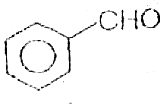Hydrazones of aldehydes and ketones are not prepared in highly acidic medium. Explain.
Step-by-Step Solution:
1. Understanding Hydrazones: Hydrazones are compounds formed by the reaction of aldehydes or ketones with hydrazine (NH2NH2). The general reaction can be represented as:
RCHO+NH2NH2→RCH=NNH2+H2O
where R represents an alkyl or aryl group.
2. Role of Acidic Medium: The reaction to form hydrazones typically requires an acidic medium to facilitate the protonation of the carbonyl oxygen. This step increases the electrophilicity of the carbonyl carbon, making it more susceptible to nucleophilic attack by hydrazine.
3. Mild vs. Strong Acidic Conditions:
- In a mild acidic medium, the carbonyl oxygen gets protonated, which leads to a positive charge on the carbonyl carbon. This enhances the reactivity of the carbonyl compound, allowing the nucleophile (hydrazine) to attack more effectively.
- In a strong acidic medium, however, the nucleophile (hydrazine) itself can become protonated, forming NH3+ (ammonium ion). This protonation deactivates the nucleophile, preventing it from attacking the carbonyl carbon and thus inhibiting the formation of hydrazones.
4. Conclusion: Therefore, hydrazones of aldehydes and ketones are not prepared in highly acidic medium because the strong acid can protonate the nucleophile (hydrazine), rendering it ineffective for the nucleophilic attack on the carbonyl carbon. This leads to a failure in forming the desired hydrazone product.
RCHO+NH2NH2→RCH=NNH2+H2O
where R represents an alkyl or aryl group.
- In a mild acidic medium, the carbonyl oxygen gets protonated, which leads to a positive charge on the carbonyl carbon. This enhances the reactivity of the carbonyl compound, allowing the nucleophile (hydrazine) to attack more effectively.
- In a strong acidic medium, however, the nucleophile (hydrazine) itself can become protonated, forming NH3+ (ammonium ion). This protonation deactivates the nucleophile, preventing it from attacking the carbonyl carbon and thus inhibiting the formation of hydrazones.
Topper's Solved these Questions
- ALDEHYDES, KETONES AND CARBOXYLIC ACIDS BOOK - PRADEEPCHAPTER - ALDEHYDES, KETONES AND CARBOXYLIC ACIDS EXERCISE - ADDITIONAL QUESTIONS (SHORT ANSWER QUESTIONS)
74 Videos
- ALDEHYDES, KETONES AND CARBOXYLIC ACIDS BOOK - PRADEEPCHAPTER - ALDEHYDES, KETONES AND CARBOXYLIC ACIDS EXERCISE - ADDITIONAL QUESTIONS (LONG ANSWER QUESTIONS)
10 Videos
- ALDEHYDES, KETONES AND CARBOXYLIC ACIDS BOOK - PRADEEPCHAPTER - ALDEHYDES, KETONES AND CARBOXYLIC ACIDS EXERCISE - NCERT EXEMPLAR PROBLEMS WITH ANSWERS, HINTS AND SOLUTIONS (LONG ANSWER QUESTIONS)
4 Videos
- ALCOHOLS, PHENOLS AND ETHERSBOOK - PRADEEPCHAPTER - ALCOHOLS, PHENOLS AND ETHERSEXERCISE - IMPORTANT QUESTIONS FOR BOARD EXAMINATIONS.
29 Videos
- APPENDIXBOOK - PRADEEPCHAPTER - APPENDIXEXERCISE - MODEL TEST PAPER <br> (Section C )
15 Videos
Similar Questions
Give reasons in one or two sentances for the following: 'Hydrazones of aldehydes and ketones are not prepared in highly acidic medium'.
View SolutionHow do you account for the following ?
(a) Boilling points of aldehydes lie between parent alkanes
(b) Aldehydes and ketones have high dipole moments
(c) NaHSO3 is used for the purification aldehydes and ketones
(d) Iodoforms is obtained byt he reactionof acetone with hypoiodite but not with iodide
(e) Hydrazones of aldehydes and ketones are not prepared in highly acidic medium
View Solution
Knowledge Check
Aldehydes and ketone are
AtautomersBchain isomersCfunctional isomersDposition isomersAldehyde and ketones are
AHomologousBIsomersCGeometricalDConformationalIn aldehydes and ketones
ACarbonyl carbon is nucleophilic and carbonyl oxygen is electrophilicBCarbonyl carbon, is slectrophilic and carbonyl oxygen is nucleophilicCBoth are electrophilicDBoth are nucleophilic
Give suitable explanation for the following:
(i) Chloral hydrate is a geminaldiol but still stable. How?
(ii) Out of and CH3CH2CHO which is more reactive towards nucleophilic addition?
and CH3CH2CHO which is more reactive towards nucleophilic addition?
(iii) Why does pure HCN fail to react with aldehydes and ketones?
(iv) Hydrazones of aldehydes and ketones are not prepared in strongly acidic medium. Why?
(v) Sodium bisulphite is used to purify aldehydes and ketones. Explain.
View SolutionGive suitable explanation for the following:
(i) Chloral hydrate is a geminaldiol but still stable. How?
(ii) Out of and CH3CH2CHO which is more reactive nucleophilic addition?
and CH3CH2CHO which is more reactive nucleophilic addition?
(iii) Why does pure HCN fail to reac with aldehydes and ketones?
(iv) Hydrazones of aldehydes and ketones are not prepared in strongly acidic mediu. Why?
(v) Sodium bisulphite is used to purify aldehydes and ketones. Explain.
View SolutionReactions of aldehyde and ketones
View SolutionReactions of aldehyde and ketones
View SolutionReactions of aldehyde and ketones
View Solution
